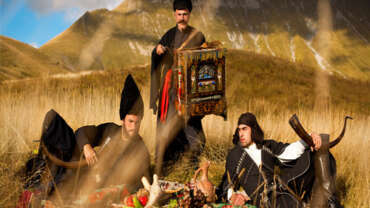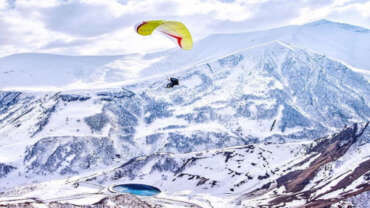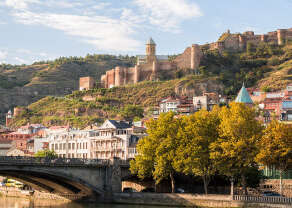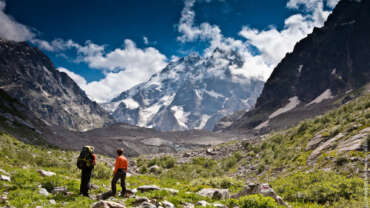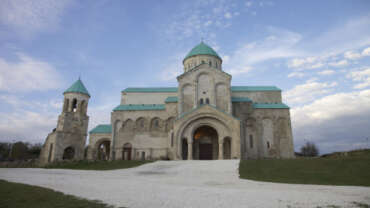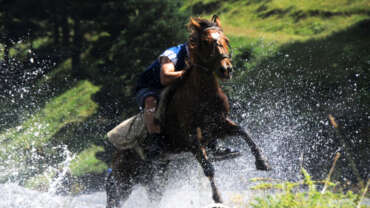Destinations in Georgia
KAZBEGI National Park
It is located on the northern slopes of the mighty Caucasus range, and its protected area covers a total of over 8,700 hectares. At 5,047 metres above sea level, Kazbegi Mountain (or Mkinvartsveri) is the third highest mountain in Georgia, and is surrounded by myths and religious tradition.
According to Greek mythology, as punishment for teaching mankind how to make fire, the Titan Prometheus was chained to a mountainside in the Caucasus for all eternity. According to Georgian stories, it was the icy slopes of Kazbegi to which he was chained. Prometheus (known as Amirani in Georgia) was supposedly imprisoned in a cave 4,000 meters high. The cave, now called Betlemi (Bethlehem), later served as a dwelling for orthodox monks, and is said to have contained many sacred relics, including Abraham’s tent and Christ’s manger.
Hot springs and acidic and carbonated lakes surround the mountain, and earth tremors are fairly frequent. Covered with 135 square kilometres of glacier, Kazbegi is a great place for ice climbing and mountaineering. The Dariali Gorge is an impossibly steep cleft in the mountains connecting Russia and Georgia, running for 18km from Stepantsminda to the Russian border at Zemo Larsi (Upper Lars). For millennia, this mountain passage has been strategically crucial, and has been fortified since at least 150 BC.
In places, the cliff faces are more than 1,000m high, and medieval watchtowers, waterfalls and wildlife make this one of the most incredible roads in the world. The steep valleys either side of the gorge are great places for bird watching. Eagles, hawks and the massive griffon vultures all nest among the rocky outcrops. The town of Stepantsminda (also called Kazbegi) itself is charming and a wonderful base camp for exploring the region further.
There are many guesthouses where locals are happy to treat you like family, rustic and beautiful with views of the mountains, and often the picturesque Gergeti Trinity Church.
Sights in Kazbegi
Stepantsminda Historic Museum
The Museum is located in the memorial house of the Georgian writer Alexander Kazbegi (1848-1890). Together with the library and personal belongings of the writer, the museum houses ethnographic artifacts typical of the Khevi region; archaeological exhibits; religious relics; books, and various works from local artists. Address: Aleksandre Kazbegi str. 2
Gergeti Trinity Church
This architectural complex from the XIV century is located in the village of Gergeti, 6 km from the town of Stepantsminda, at a height of 2200 m. The complex includes Holy Trinity Cathedral, constructed in the XIV century, the bell tower built in the XIV century, and clergy houses from the XV century. You can hike up to the complex in about two hours, hire a driver, or even rent a horse!
Gveleti Waterfall
The waterfall is located in the village of Gveleti, 7 km from the town of Stepantsminda. You must first drive through the stunning Dariali Gorge, from which a short, leisurely hike up a narrow footpath leads the way to the Gveleti waterfall. Gveleti means “place of snakes” in Georgian, so keep an eye out for local wildlife!
Devdoraki Glacier
A hiking trail leading to the glacier starts in Stepantsminda and follows the Dariali Gorge. Along the way you will pass the Gveleti waterfall, as well as a birch forest, and a wide variety of plants typical for the Alpine climate.
Dariali Gorge
The gorge begins at the confluence of the river Chkheri (close to Stepantsminda) and ends near Upper Lars. The Gorge itself is 11 km long. The confluence of the Kabakhi and Khda rivers is the most narrow and rocky part of the gorge. You will also have an opportunity to see a Georgian Orthodox Church located within the gorge.
Upper Truso Gorge
You will encounter plenty of historic and cultural sites here, including abandoned villages, colorful sediment deposits from mineral waters, and glacial and river deposits. Truso Gorge is rich in carbonated mineral waters. You will also find birch forests throughout.
Khada Gorge
The Gorge is located near the Russian border at Upper Lars. This area is mostly visited by mountain climbers. To get here you will pass through the Dariali Gorge, where a hiking trail passes a newly built monastery complex and leads through the riverbed of Brolistskali. The distance from Stepantsminda to the monastery is about 11 km and the length of the footpath is approximately 17 km.
Gorge Of Artkhmo
The gorge begins at the village of Akhaltsikhe (the Sno Gorge) and stretches along a riverbed of Artkhmostsqali. Here you can visit the ancient abandoned villages Miguda and Artkhmo, and see beautiful waterfalls along the way. Akhaltsikhe is a small town located 10 km away from Stepantsminda.
Village Sno
If you blink, you’ll miss this tiny settlement, located about 5 km from Stepantsminda. The home of the Patriarch of the Georgian Orthodox Church is here, and there is a small church in the courtyard of the residence. Sno also has a large statue of Vakhtang Gorgasali, and a tower fortification from the XVI century.
Juta
The village of Juta is one of the highest settlements (2200 m) in the municipality of Kazbegi, and is located 24 km from Stepantsminda (8 km of paved road, and the remainder is a dirt road). The Chaukhi mountain range, located near the village, is situated on the main ridge of the Caucasus mountain range, at the source of the river Bakurkhevi.
Tbilisi
Georgia’s ancient and vibrant capital city spreads out on both banks of the Mtkvari River, and is surrounded on three sides by mountains. The most widely accepted variant of the legend of Tbilisi’s founding says that in the mid-5th century AD, King Vakhtang I Gorgasali was hunting in the heavily wooded region with a falcon. The King’s falcon allegedly caught or injured a pheasant during the hunt, after which both birds fell into a nearby hot spring and died from burns. King Vakhtang became so impressed with the hot springs that he decided to cut down the forest and build a city. The name Tbilisi derives from the Old Georgian word “tbili”, meaning warm. Archaeological studies of the region indicate human settlement in the area early as the 4th millennium BC.
Sights in Tblisi
Old Tbilisi
The main sights of the city are clustered in the Old Tbilisi district. This area is well-known for its sulfur bathhouses fed by natural hot springs. Nearby on Shardeni Street you will find plenty of modern, popular restaurants, open air café-bars, trendy night clubs and art galleries.
Narikala
Narikala Fortress can be seen from any point within Old Tbilisi. It was constructed for defense purposes in the 4th century and was considerably expanded over subsequent historical periods.
Rustaveli Avenue And Freedom Square
Rustaveli Avenue begins at Freedom Square and extends about 1.5 kilometers. This is the center of the city, where many of the governmental, cultural and business facilities are located. Strolling down Rustaveli you can observe daily life in the city, explore shops from both international and local brands, and get something to eat.
Dry Bridge
The Dry Bridge is home to a famous flea market, where you can find art exhibitions and antique items for sale. Whether you’re interested in Soviet memorabilia, handmade jewelry, or personal keepsakes- remember to haggle! Open daily in good weather from 10:00 – 17:00.
Funicular
The Tbilisi Funicular is one of the finest examples of cable railways in the world. The railway leads to Mtatsminda- a beautiful leisure and amusement park overlooking the entire city.
Agmashenebeli Avenue
Agmashenebeli Avenue is one of the longest and most beautiful streets of the city. Here you can find gorgeous historic buildings, painted entryways and distinctive architectural ornaments.
Simon Janashia Museum Of Georgia
The museum’s origins date back to the 19th century. Today, the museum exhibits Georgia’s principal archaeological findings, thousands of artifacts of immense historical significance, animal remains dating back 40 million years, and archaeological and ethnographic collections from the Paleolithic, Neolithic, Bronze, Iron and Middle Ages. Address: 3 Shota Rustaveli Avenue.
Art Museum Of Georgia
Located near Freedom Square, the Art Museum of Georgia is one of the most important museums in the country. There are approximately 140,000 items of art on display from various cultures and time periods.
Gabriadze Theater
Founded in 1981, it became the first Georgian puppet theater. The building is decorated with a magnificent clock tower which features a performance of figurines everyday at 12:00. Address: 13 Shavteli Street.
Holy Trinity Cathedral
The Trinity (Sameba) Cathedral is one of the tallest Eastern Orthodox cathedrals in the World. The cathedral complex includes an underground section and integrates nine chapels, various supplementary buildings, and beautiful gardens.
Art Palace Of Georgia
The Georgian State Museum of Theatre, Music, Cinema and Choreography – Art Palace is an important depository of Georgian cultural objects. The museum is housed in one of the most stunning buildings in Tbilisi which is a perfect example of Gothic and Islamic architecture.
Mtskheta
It is a UNESCO World Heritage Site. It has been inhabited since before 1,000 BC and was once the capital of the early Kingdom of Iberia (today’s Eastern Georgia). Just 20 km from Tbilisi, at the confluence of the Mtkvari and Aragvi rivers, the city is located on an ancient trade route. Archaeologists have unearthed evidence of Mtskheta’s status as a major trading post. Glass perfume bottles, Greek and Aramaic writings, pottery, metalwork and jewelry have all been unearthed in abundance here, and many examples are on show in the town’s museum.
The ancient geographer Strabo described Mtskheta as a highly developed city with a water supply system, markets and stone houses. Mtskheta was also the religious centre of the country, with a number of major shrines to Georgia’s pagan pantheon; these would later be replaced by churches when St. Nino converted the country to Christianity in around 337 AD. Although the capital was moved to the more easily defended Tbilisi at the beginning of the VI century, Mtskheta continued to be the coronation and burial place of Georgian kings, and the seat of the Patriarch, who is also known as the Bishop of Mtskheta. Today, the lovely old town has a laid back, village feel, especially compared to the more hectic pace of Tbilisi.
Sights in Mtskheta
Svetitskhoveli Cathedral
This Georgian architectural wonder dating back to the XI century has served as the religious center of the country for hundreds of years. The complex includes the church, a gate, a bell tower, castles, and clerical residences. The mantles of Christ and of the Prophet Elijah are both preserved in the Svetitskhoveli Cathedral. The tombs of Tbilisi’s founder, King Vakhtang Gorgasali is also inside the building. The cathedral is included on the UNESCO World Heritage Site list.
Mtskheta State Archaeological Museum-Reserve
The Museum-Reserve contains archaeological artifacts of national and international importance. A wide variety of exhibits from the Bronze, late Middle Ages, and various ethnographic pieces are also on display.
Bebristsikhe
Bebristsikhe castle is located north of Mtskheta, on the right bank of the river Aragvi. It was called Belta in ancient times. The castle was built in the antique period; its total area equates to approximately 1500 m2 and the inner courtyard is about 600 m2.
Jvari Monastery
The VI century Georgian Orthodox monastery is built on a hill opposite Mtskheta, at the confluence of Aragvi and Mtkvari rivers. Shortly after the adoption of Christianity, King Mirian III erected an enormous wooden cross on this site. In the 2nd half of the VI century Guaram, the ruler of Kartli, built a small church beside the Holy Cross. The church is included on the UNESCO World Heritage Site list.
Armaztsikhe (Bagineti)
This historic archaeological monument is located along Mtskheta-Tbilisi highway. Its name is linked to the pagan idol Armazi which was proclaimed the supreme deity by King Parnavaz. Archeological findings on the territory of Armaztsikhe include segments of wall, towers, structures of the royal residence, and the ruins of the burial vault. Locals refer to Armaztsikhe as Bagineti.
Armazi Fortress
Considering its scale and age, Armazi is one of the most important fortresses in the country. Currently, the remains of the fortress occupy 30 hectares. The fortress used to control the road to bordering countries beyond the Caucasus.
Monastery Of Shio-Mgvime
The monastery is located 8 km from Mtskheta, on the left bank of the Mtkvari River. It was constructed in the beginning of the second half of the VI century by one of the Assyrian fathers named Shio. The complex includes facilities of different time periods: a cave church, the Church of St. John the Baptist, a bell tower, the church of Shio, St. Mary’s Assumption Cathedral with its tower, refectory, and rock-cut caves – reservoirs, clergy houses, a spring, a water supply system and the Ascension Church.
Zedazeni
The Zedazeni complex is located 6 km south of the village of Saguramo, on the top of a mountain covered in deep forests. The complex includes the Church of St. John the Baptist, a fortress, and monastic cave cells.
Ilia Chavchavadze Saguramo State Museum
The museum complex includes the residence, auxiliary buildings, and the family vineyards of the famous Georgian writer and public figure Ilia Chavchavadze (1837-1907). The museum preserves memorial items and manuscripts from the writer, photo portraits of famous XIX century Georgian public figures and photographs reflecting the time period.
Gori
The original fortress, constructed on a hilltop, was named Gori (meaning hill in English), and was mentioned in the Georgian chronicles as early as the VII century. Some historians believe that the fortress was built by Byzantine Caesar Heraclius to store ammunition battles against the Persians.
Just after the XI century the area became an active center for trade. According to some historians, this was due to David the Builder founding the town. Because of its geographical location, enemies frequently targeted the fortress, as conquering it enabled control of the whole Shida Kartli region. The fortress has been invaded many times and controlled by Ossetians, Iranians and Persians, amongst others. The stronghold has been repeatedly destroyed and rebuilt.
The current iteration of the fortress was built in 1774, during the reign of Erekle II, but was significantly damaged by an earthquake in 1920. The Stalin Museum includes the memorial house where Joseph Stalin (1879-1953) was born, a museum building with a tower, and Stalin’s personal train car he used to visit Tehran, Yalta, and Potsdam. There are many unique exhibits displayed here, including personal belongings and collections of paintings, photos, films and other important historical artifacts.
Sights in Gori
Gori Fortress
The historic fortress stands on a rocky hill in the center of Gori. The ruins on the northern slope and the archaeological findings indicate that there was a fortress here as far back as the I century BC. In historic manuscripts the fortress is first mentioned in the XIII century as “Gori Prison.”
Virgin Mary Cathedral
The temple was built as a Catholic church between 1806 and 1810. In 1920, it was heavily damaged by an earthquake. During Soviet times, Gori’s Music School was situated in the church. The building was handed over to the Georgian Orthodox Church in the 1990s. Currently, Samtavisi and Gori Cathedral belong to the episcopacy.
Historical-Ethnographic Museum
The museum was founded in 1935. Currently, it houses more than 48,100 exhibits, including: handcrafted metal masterpieces, paintings, decorative sculptures, heraldic artifacts, unique Colchis silver coins (the only ones in the former USSR), coins dating back to the time periods of Queen Tamar and David Narin, ancient Eastern coins, epigraphic monuments in Georgian and Arabic languages, collections of manuscripts in the Georgian language, a vast photo archive, and many more attractions.
State Museum Of Joseph Stalin
Soviet leader Joseph Stalin’s Museum was founded in 1937 and contains 60,000 exhibits. The museum includes the memorial house where Stalin is believed to have been born, an exhibition building, and Stalin’s personal train car, in which he traveled to Tehran, Yalta and Potsdam. The museum also houses Stalin’s personal belongings.
Gorijvari
A church complex and local resort, located at an altitude of 600 meters. Low mineralized hydrosulfite, hydrocarbon-chloride and sodium mineral water are used to prepare special therapeutic baths. The baths are used for treatment of musculoskeletal system issues and gynecological diseases; they also have a positive effect on the nervous system. The season for the resort usually runs June through September.
Uplistsikhe
Uplistikhe is a rock-hewn city, located just 10 km east of Gori, on the left bank of the river Mtkvari. One of the oldest settlements in the Caucasus region, Uplistikhe is first mentioned within the pages of history in the VII century. Uplistiskhe and its surrounding archeological and architectural monuments belong to a distinct group, the oldest of which dates back to the early Bronze Age, and are considered to be relics of the Kura-Araxes culture.
Ateni Gorge
Alongside the natural biological diversity, the Ateni Gorge features plenty of tourist sites: Great Ateni – Ateni Sioni Church (VII Century), Ateni (Orbeliani) Fortresss (X-XI centuries), the Church of the Virgin Mary, mineral water “
Village Gardateni
The village is located 6 kilometers from the town of Gori. Here you will find several important historic monuments, including: Vere fortress, the Church of Saint George, Vere Church of the Virgin Mary, the Green (Transfiguration) cathedral, Tsedisi Fortress, and other architectural monuments.
Ruisi Cathedral Of Transfiguration
The cathedral dates back to the VIII-IX centuries and is located 7 km from the town of Gori. According to sources, it was built by King Vakhtang Gorgasali. Despite the fact that the original structure of the building was not preserved, the VII century architectural style can easily be identified when looking at the building. Ruisi is associated with a number of important political events of the feudal age. Within the walls of this church, George II (1072-1083 AD) was crowned the King of Kartli.
Urbnisi Cathedral
The cathedral is located within the Kareli municipality, in the village of Urbnisi. Stylistic elements, as well as paleographic assessments of inscriptions on the northern faзade estimate that the cathedral was constructed sometime in the V-VI centuries. The inscriptions on the facade feature names of the architects – Konstantin and father Mikheil. The rest of the inscriptions refer to dates of the church’s restorations.
Zugdidi
The city is the capital of the Samegrelo-Zemo Svaneti region, which combines Samegrelo (Mingrelia) and Svaneti. The name “Zugdidi” means “big/great hill” in Laz and Mingrelian.
Zugdidi served as the capital of the principality of Mingrelia (Odishi) until 1867, when the principality was abolished by the Russian Empire. In 1993 the administration of the first President of Georgia, Zviad Gamsakhurdia, was here.
Sights in Zugdidi
Dadiani Palace History And Architectural Museum
In 1839 David Dadiani founded his family’s museum. The museum is one of the oldest in the Caucasus region, and currently houses more than 41,000 items, ranging from the second millennium BC to the end of the 19th century AD. Some of the most interesting items include Napoleon’s death mask dated 1833, a Napoleonic library of several hundred volumes, private letters, and Napoleonic silver and chinaware.
Ganmukhuri And Anaklia (Black Sea Resorts)
Ganmukhuri and Anaklia are two Black Sea resorts connected to each other by a 552 meter pedestrian bridge. The resorts attract tourists for their sandy beaches, peaceful boulevards, hotels, water parks, and yacht clubs.
Kolkheti National Park
The National Park was created in order to protect and maintain the Kolkheti wetland ecosystems, which are of international importance. The Kolkheti National Park Administration offers boat tours on lake Paliastomi and river Pichori, as well as sport fishing, bird watching and eco-educational tours. Tours are carried out throughout the year.
The Swinging Rock – “Kuakantsalia”
This rock stands on the limestone massif in Tsalenjikha – 27 kilometers from Zugdidi. What makes this particular place so special is that a simple touch of a human hand is enough to make this giant rock shake and create loud knocking sounds.
The Khobi Monastery
The Khobi Monastery dates back to the 13th-14th centuries, it is located in the village of Nojikhevi, some 30 kilometers from Zugdidi. The church is decorated with beautiful frescos and wall ornaments. During the middle ages the Khobi Monastery served as the seat of the Catholicos Patriarch of Georgia. This area is particularly attractive for tourist interested in archaeology.
Skuri
The resort is well-known for its mineral water “Skuri”, which has medicinal properties. Within the beautiful Skuri valley, you will also find the “White Fortress” dating back to the 1st–3rd centuries.
Complex Of “Otsindale”
The Otsindale complex is situated 640 meters above the sea level, overlooking the beautiful Kolkhetivalley. The complex combines a church, which dates back to the 11th century, and a tower, which was constructed around the 8th century.
Shurubumu
Shurubumu is an enchanting wonder of the natural world. The area is covered with lush green moss and thousand-year old buxus trees. You will also find a cave in the area, with numerous stalactites and stalagmites.
Canyon Of Intsra
The cave is located within the basin of the river Instra; inside the cave you will find numerous stalactites, stalagmites and helictites. The water flowing out of the cave creates a 26 meter high beautiful waterfall. Location: village of Chkvalevi, municipality of Tsalenjikha.
Inguri Hydropower Plant
Inguri dam is the second highest concrete arch dam in the world. It was built in the 1970s as part of the Inguri Hydropower Plant. Location: north of the town of Jvari.
Kutaisi
Kutaisi, the capital of Imereti, is Georgia’s second largest city after Tbilisi. Elegant, tree lined streets with 19th century houses stretching down to the banks of the Rioni River, along with several attractive parks, make Kutaisi a very beautiful place to stroll around and take in the many sights.
In the Jewish Quarter a number of synagogues demonstrate the long history of the Georgian Jewish community. The town’s largest synagogue, built in 1866, can seat 500 worshipers. The magnificent churches of Bagrati and Gelati – both UNESCO world heritages sites – testify to the importance of the region.
Sights in Kutaisi
Bagrati Cathedral
The construction of Bagrati Cathedral, named after Bagrat III – the first king of a united Georgia, started at the end of the 10th century and was completed in the early years of the 11th century. The Cathedral holds special importance in the history of Georgia as an architectural and cultural monument.
Gelati Monastery
The cathedral is situated 11 km westwards from Kutaisi. The Gelati Monastery, with its main buildings erected between the 12th and 17th centuries, was an important religious, cultural and educational center of Georgia. The monastery complex is included in UNESCO’s World Cultural Heritage list and its architecture is well known for wonderful mosaics and frescos. King David the Builder, the most celebrated King of Georgia, is buried in the yard of the monastery.
Motsameta Monastery
Motsameta Monastery is located 6 kilometers from Kutaisi. The present day church dates back to the 11th century, but historic records show that a church was constructed in this spot as early as the 8th century. Motsameta attracts crowds of tourists with an ancient superstition: if one crawls three times under the ark and makes a wish while touching the hallows, the wish will come true.
Kutaisi State Historical Museum
Kutaisi State Historical Museum was founded in 1912 and houses over 200,000 artifacts.
Historical District Of The City
The historical part of Kutaisi – the Royal District, includes the areas surrounding the White bridge, Tsisferkantselta str., St. Nino str., Tsereteli and Pushkini str.
Vani Archeological Museum
This museum holds the majority of the archeological discoveries from the site of Vani. In 1987, the Gold Reserve was opened within the museum, which preserves the unique pieces created by Vani’s ancient goldsmiths. The exhibition also displays architectural materials, as well as unique bronze figures and their fragments.
Sataplia Nature Reserve
Sataplia Nature Reserve is located 6 kilometers North-West of Kutaisi. Here you can find preserved dinosaur footprints and a beautiful cave complex featuring numerous stalactites and stalagmites. Within the area of the reserve there is a museum and a glass walkway overlooking breathtaking natural scenery.
Prometheus Cave
Prometheus Cave is located 40 kilometers from Kutaisi near Tskaltubo. The cave is one of the most popular destinations in the region, and includes various types of stalactites, stalagmites, curtains, petrified waterfalls, underground rivers, and lakes. Each cave in the cluster of six differs significantly from each other in scale and the unique shapes of petrified flowstones found within. Here you will also have a chance take a boat tour though an underground lake.
Katskhi Pillar
Located 60 kilometers from Kutaisi; in the village of Katskhi, the Pillar is a natural limestone monolith. It stands 40 meters tall, overlooking the surrounding river valley. There is a small church and a clergy house on top of the Pillar.
Okatse Canyon
Okatse Canyon is situated in the village of Gordi, some 42 kilometers from Kutaisi. The length of the canyon is about 16 kilometers, its width ranges from 10 to 15 meters, and it is about 50 meters deep. Along the canyon you can find several waterfalls, one of which measures 70 meters high.
Mestia
The main regional center of Zemo (Upper) Svaneti, is situated 456 km from Georgia’s capital city, Tbilisi, and is 1,500 meters above sea level. It is the starting point for most trips to Svaneti, with a range of hotels, guesthouses and local travel services, and makes a convenient base for exploring the area. From the center of Mestia it is possible to hike up to the glaciers at the foot of mount Ushba, or take horses into the pristine alpine meadows. New ski resorts Hatsvali and Tetnuldi attract the attention of winter sports lovers who are looking for the new places and challenges.
Tourists interested in religious history will find plenty of examples of wall paintings, frescoes and icons from the Middle Ages in the churches around Mestia. Within Mestia, the Church of Saint George contains well-preserved crosses and icons from the XII century. Additionally, Pusdi Church still contains fragments of XIII century wall paintings.
Sights in Mestia
Svaneti Historic And Ethnography Museum
The museum was founded in 1936 and houses historic artifacts from the Svaneti region, including unique icons and engravings, a rich collection of manuscripts, medieval weaponry, iron, silver and copper ornaments, jewelry, pottery, and a collection of textile items, ethnographic artifacts depicting ancient life in Svaneti, and more.
Museum Of Michael Khergiani
The ground floor of the museum houses personal items of the famous alpinist – Merited Master of Sport Michael Khergiani (1932-1969). Among the collection you will find climbing equipment, clothing, photos, awards, and gifts – including several musical records by Vladimir Vysotsky and a song which he dedicated to Khergiani
Transfiguration Cathedral In Laghami
is located in Laghami – the oldest part of the town of Mestia. The first floor of the two-story basilica is named after the Great Martyr Barbara (Barblash) and dates back to the IX century. The second floor was constructed in XIII-XIV centuries and decorated with beautiful frescoes. The outer wall of the Cathedral is also covered with paintings. The northern facade depicts the “Banishment of Adam and Eve from the Garden of Eden,” while the eastern wall features “Hunting of St. Eustaphios.” The cathedral also houses a XIII century gold and silver engraved icon of Christ (pantokratori).
Ski Lift And The View From Zuruldi
About 8 km from Mestia, you will arrive in Hatsvali, where a 1.5 kilometer long ropeway will take you to mount Zuruldi. This mountain is well known for its unique views of the white slopes of Tetnuldi and the Caucasus mountain range. During the winter months, this area features a 2,400 meter long ski slope.
Chalaadi Glacier
The glacier is located on the southern slopes of the Caucasus Mountains, at the source of the river Mestia- Chala. The height of the glacier is 1850 meters. Chalaadi is the only glacier that extends into the forest zone. The glacier is fed by the mountain streams Bzhedukhi, Chatini and Dalaqori.
Ushguli
Ushguli is located in the municipality of Mestia, at the bottom of mountain Shkhara, near the confluence of rivers Inguri and Shavtsqala-Kvishara. The community is comprised of 4 villages (Zhibiani, Chvibiani, Murqmeli and Chazhashi) and their height ranges from 2060 meters to 2200 meters above sea level. This makes Ushguli the highest settlement in Europe. The center of the community, Chazhashi, has been declared a museum and is a UNESCO World Heritage Site.
Kala
Located in the Municipality of Mestia, Kala includes 8 villages: Agra, Ipari, Lalkhori, Davberi, Khe, Vichnashi, Khelde and Laskrali. The major tourist attractions are the XI century Ipari church, the XI century St. Kvirike Church (Lagurka) and the village Kheshi.
Adishi
Within the vicinity of the village Adishi, you can find numerous monuments of medieval Georgian art: four churches featuring beautiful frescoes, traditional houses, unique towers, and samples of engraved artwork.
Ipari-Nakipari Church Of St. George
The eastern facade of the chapel features depictions of animals. The interior of the church was painted in 1130 by a man named Theodore, who was an artist for the King. An engraved icon of St. George, crafted by an XI century goldsmith is preserved in the church as well.
Church Of Christ
Located in the village of Latali, the local people refer to it as “matskhvarishi.” Constructed in the X century, the quality of artistry in the church is mesmerizing. It also houses a XII century Byzantine cross decorated with cloisonné enamel.




